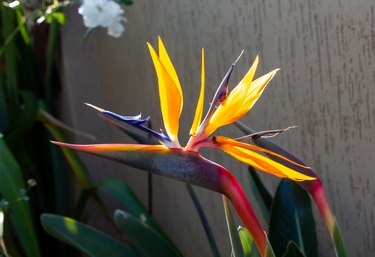
The brightly colored bird-like flowers of the bird of paradise (Strelitzia spp.) flourish in sun or partial shade in warm gardens. While the bird of paradise plant species are hardy in U.S. Department of Agriculture plant hardiness zones 9 through 11, be sure to protect the rhizomes from freezing temperatures in zone 9 and the occasional frost in zone 10. The large, banana-like leaves of bird of paradise provide a tropical flair to your garden or to a sunny window indoors.
Tip
Plant your bird of paradise in full sun or partial shade. A sunny location generally results in smaller flowers on shorter stems, while partial shade encourages taller stems with larger flowers.
Video of the Day
Bird of Paradise Plant Species
The bird of paradise (Strelitzia reginae) grows up to 5 feet tall and equally wide, with orange and blue flowers on stalks rising above the 6-inch-wide and 18-inch-long green leaves. While generally evergreen, when exposed to frosts and freezing temperatures, the leaves die back to the ground. If the rhizomes are protected by a thick layer of loose mulch so the soil doesn't freeze, the plants will grow back when the weather warms.
Video of the Day
In addition to the orange and blue bird of paradise and its yellow and blue cultivar 'Mandela's Gold,' there are several closely related species with similar growth habits. The white bird of paradise (Strelitzia alba) can grow up to 30 feet tall and 10 feet wide in a tree-like form under ideal conditions. Another huge species is the giant bird of paradise (Strelitzia nicolai), also known as white bird of paradise, which grows up to 30 feet tall and 20 feet wide.
No matter which bird of paradise species you select for your garden, keep it out of reach of children and pets. Ingestion of any part of the plant, particularly the fruits and seeds, can cause nausea, vomiting and drowsiness.
Planting the Bird of Paradise
A native of South Africa, the bird of paradise prefers a well-drained soil in a warm, wind-sheltered location. While these heat-loving plants grow well in full sun, you can plant strelitzia in sun or shade. A bird of paradise in shade may result in taller stems and fewer but larger flowers.
Dig in 2 to 4 inches of compost, then plant the potted plants or rhizomes at the same depth as they were in their original location. If planting seeds, scarify the hard outer shell with a file and soak overnight. Seeds germinate in six to 12 weeks when kept moist at 75 to 90 degrees Fahrenheit. When grown from rhizomes, the plants will flower in two to three years, while plants grown from seeds may require four to 10 years and may not resemble the parent plant.
Growing in Flowerpots
When planting in flowerpots for indoor gardens, use a well-drained, organically rich potting mix. Start with a pot that is at least twice as wide as the rhizome and repot into a larger container every two years in spring.
Keep indoor plants in bright light or a sunny window to encourage flowering and mist regularly. While most potted houseplants can go outside for a summer vacation, keep the bird of paradise in shade or partial shade and be sure to bring it indoors when temperatures drop below 55 degrees Fahrenheit at night.
Caring for Bird of Paradise
Water the bird of paradise when the top 1 to 2 inches of soil is dry; don't overwater. Reduce watering from November until April. Add a 2-to-4-inch layer of mulch around the plant to help reduce evaporation from the soil and discourage weeds. When frosts or freezing temperatures threaten, cover the foliage with a frost blanket and add more mulch.
Fertilize outdoor plants with a slow-release fertilizer formulated for flowering plants in spring. Feed potted plants with a liquid fertilizer every two weeks during the growing season.
Sterilize your cutting tools using rubbing alcohol or Lysol. Remove dead leaves and old flower stalks to clean up the plant. Divide plants in late spring or early summer, making sure each rhizome has a leaf stalk. Replant at the same depth and keep the soil moist for at least three months to help the rhizomes develop new roots.